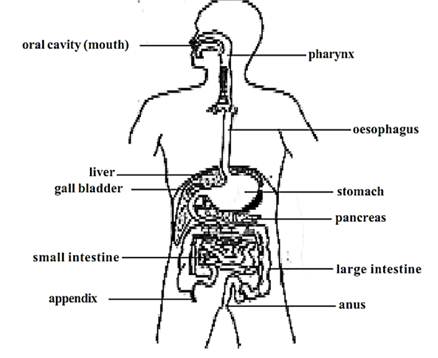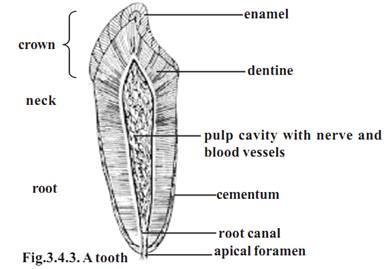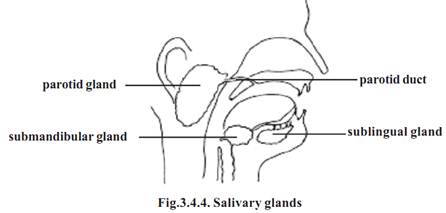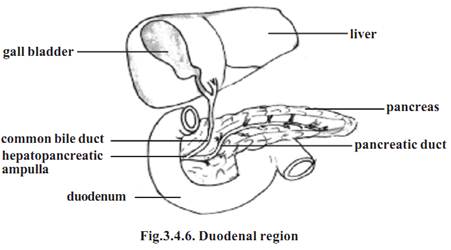


 النبات
النبات
 الحيوان
الحيوان
 الأحياء المجهرية
الأحياء المجهرية
 علم الأمراض
علم الأمراض
 التقانة الإحيائية
التقانة الإحيائية
 التقنية الحيوية المكروبية
التقنية الحيوية المكروبية
 التقنية الحياتية النانوية
التقنية الحياتية النانوية
 علم الأجنة
علم الأجنة
 الأحياء الجزيئي
الأحياء الجزيئي
 علم وظائف الأعضاء
علم وظائف الأعضاء
 الغدد
الغدد
 المضادات الحيوية
المضادات الحيوية|
Read More
Date: 5-11-2015
Date: 1-8-2021
Date: 30-7-2021
|
Digestive system
The process of nutrition in man is holozoic. In this type of nutrition, the nutrients are made available to the body through digestion of food. In digestion, the macromolecules or biopolymers of food are hydrolyzed to yield their corresponding monomers. This process is facilitated by enzymes. Thus the digestive system comprises the alimentary canal, associated glands and regions of absorption of food. The digestive tract comprises various organs from mouth to anus.

Fig 1 : Digestive system
Mouth or Buccal cavity
The opening of the oral cavity is bounded by the lips. The lips are muscular folds covered internally by mucosa. The lateral walls of the oral cavity are the cheeks. The inner walls of the cheeks are lined by moist stratified squamous epithelium. The lips and cheeks are useful in the process of mastication and speech.
Tongue - It is a large muscular organ. It is attached to the floor of the oral cavity. The anerior part of the tongue is free. A thin fold of tissue called the frenulum attaches the free end to the floor of the mouth. The tongue is divided into two parts by a groove called the terminal sulcus. About two thirds of the anterior surface is covered by papillae. Some of them contain taste buds.
Teeth - There are 32 teeth in the mouth of a human adult. These are called as permanent teeth. There are 4 different types of permanent teeth seen. This nature is known as heterodontism. The types of teeth are incisors (8), canines (4), premolars (8) and molars (12). Since the teeth in the right and left side of the mouth are mirror images of each other, the dental arrangement is represented as follows.
I 2/2: c 1/1 : pm 2/2 m 3/3 X 2 or

Fig 2 : Dentition
Each tooth consists of three regions. These are the upper crown, middle neck and basal root regions. The crown region has one or more cusps. The tooth is made up of a calcified tissue called dentine.
The dentine of the tooth crown is covered by an extremely hard substance called enamel. The surface of the dentine in the root is covered with a bonelike substance called cementum. It helps to anchor the tooth in the jaw. In the center of the tooth there is a pulp cavity. This cavity is also called as the root canal. This canal contains blood vessels and nerves. The canal opens at the base through apical foramen.
The teeth are set in sockets along the edges of the upper and lower jaws. This region of the jaw is covered by dense fibrous connective tissue and stratified squamous epithelium. It is called as the gingiva.

Salivary glands: These are scattered throughout the oral cavity. Three pairs of glands are larger. They are the parotid, submandibular and sublingual glands. The Parotid glands are the largest. They are located just anterior to

the ear on each side of the head. The submandibular glands are found on the inferior borders of the mandible. The sublingual glands are the smallest. They lie immediately below the mucous membrane in the floor of the mouth. There are other numerous small, coiled, tubular glands in the mouth. They are the lingual (tongue), palatine (palate), buccal and labial (lips) glands.
Pharynx: A description of pharynx is provided under respiratory system.
Oesophagus: This part of the digestive tube extends between the pharynx and the stomach. It is about 25 cm long. It lies in the mediastinum of the thorax, anterior to the vertebra and posterior to the trachea. It passes through the diaphragm and ends at the stomach. The oesphagus has thick walls. The inner wall is lined by a moist stratified squamous epithelium. The upper and lower ends of this tube have sphincters to regulate the movements of materials.
Stomach: It is an enlarged sac like structure. This sac found in the upper part of the abdomen is horizontally placed. It is divisible into two regions namely cardiac and pyloric stomachs. The cardiac stomach is towards the left of the abdomen. The oesophagus opens into the cardiac stomach through the gastroesophageal or cardiac opening. A part of the stomach to the left of the cardiac region is the fundus. The largest part of the stomach is the body. The body narrows to form the pyloric region. The pyloric opening between the pylorus and intestine is surrounded by a ring of muscles called the pyloric sphincter.

Small intestine: It consists of three parts: the duodenum, the jejunum and the ileum. The entire small intestine is about 6m. long.
Duodenum - It is about 25 cm. long. It curves within the abdominal cavity and completes nearly 180 degree arc. Liver and pancreas are associated with the duodenum.
Jejunum and ileum- The jejunum and ileum are 2.5m. and 3.5m in length respectively. These two are similar in structure to the duodenum. However there is a gradual decrease in the diameter of the small intestine. The junction between the ileum and the large intestine is the ileocaecal junction. It has a ring of smooth muscles forming a sphincter, and a one way ileocaecal valve.
Liver: It is the largest visceral organ. It weighs about 1.36 Kg. The liver consists of two major left and right lobes, and two minor lobes caudate and quadrate. The bile secreted by the liver gets collected in the gall bladder. There are two hepatic ducts and they unite to form a single duct. The common hepatic duct is joined by the cystic duct from the gall bladder to form the common bile duct. It empties into the duodenum.
Gall bladder: It is a sac like structure on the inferior surface of the liver. It is about 8 cm long and 4 cm wide.

Pancreas: It is a complex organ. It is composed of both endocrine and exocrine tissues. The endocrine part of the pancreas consists of pancreatic islets. They produce insulin and glucagon. The exocrine part of the pancreas consists of acini. They produce digestive enzymes. The pancreas consists of several lobules. The ducts from the lobules unite to form the pancreatic duct. It joins the common bile duct at the hepatopancreatic ampulla.
Large intestine.
Caecum: It is the proximal end of the large intestine. At this region large and small intestines meet. The caecum is about 6 cm in length. Attached to the caecum is a small blind tube about 9 cm long. It is called the vermiform appendix.
Colon: It is about 1.5 - 1.8 m long. It consists of four parts namely the ascending colon, transverse colon, descending colon and sigmoid colon. The sigmoid colon extends into the pelvis and ends at the rectum.
Rectum: It is a straight, muscular tube that extends from the sigmoid colon to the anal canal.
Anal canal: It is the last 2cm of the digestive tract. It ends at the anus. The canal has two sphincters, namely the internal anal sphincter and the external anal sphincter.
References
T. Sargunam Stephen, Biology (Zoology). First Edition – 2005, Government of Tamilnadu.



|
|
|
|
"عادة ليلية" قد تكون المفتاح للوقاية من الخرف
|
|
|
|
|
|
|
ممتص الصدمات: طريقة عمله وأهميته وأبرز علامات تلفه
|
|
|
|
|
|
|
المجمع العلمي للقرآن الكريم يقيم جلسة حوارية لطلبة جامعة الكوفة
|
|
|